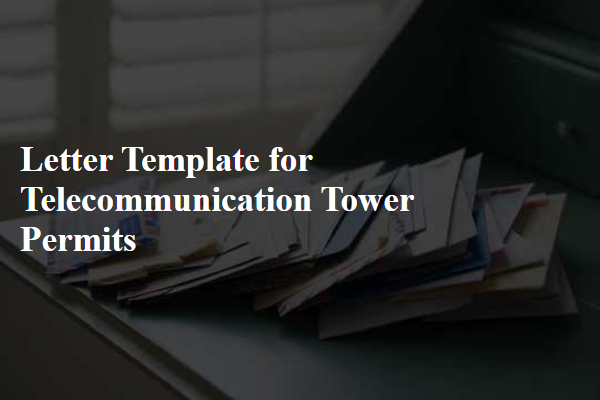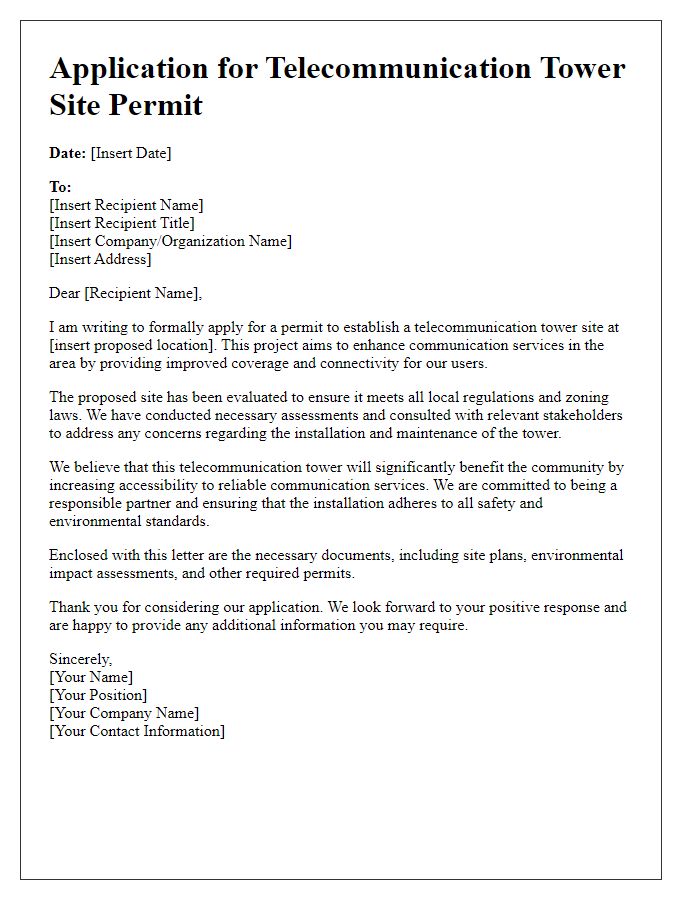Are you looking to navigate the often-complicated process of obtaining permits for telecommunication towers? This essential guide breaks down the steps you need to take, ensuring you have all the necessary information at your fingertips. From understanding local regulations to preparing the correct documentation, we'll help you streamline your application and avoid common pitfalls. Dive in to discover expert tips and resources to make your permitting journey seamless!

Regulatory Compliance
Telecommunication towers, essential for mobile network infrastructure, must adhere to regulatory compliance standards set by federal agencies like the Federal Communications Commission (FCC) in the United States. These permits are crucial for ensuring that towers, often standing over 200 feet tall, meet safety and environmental guidelines. The application process includes detailed documentation such as site plans indicating location, height specifications, and structural integrity certifications. Additionally, environmental assessments, particularly in designated areas like wetlands or historical sites, are necessary to minimize impact on local ecosystems. Failure to comply with these regulations can result in hefty fines or project delays, affecting deployment timelines for important advancements in telecommunications services.
Zoning and Land Use
Telecommunication towers, often referred to as cell towers, require specific zoning and land use permits to ensure compliance with local regulations. The permitting process involves submitting applications to municipal offices that manage land use, zoning laws, and safety regulations. Various assessments, such as environmental impact studies and community impact statements, may be necessary to address concerns raised by residents regarding noise, visual aesthetics, and property values. Additionally, local regulations may dictate the height (typically ranging from 50 to 200 feet) and location of these towers to maintain urban planning standards and protect public safety. Engagement with community members during public hearings is also a vital part of the process, allowing for transparency and discourse on the proposed tower's placement and its implications on the surrounding area. Local government entities, such as zoning boards or planning commissions, typically oversee these processes to ensure that telecommunication infrastructure meets both regulatory standards and community needs.
Environmental Impact Assessments
Telecommunication tower installations often require Environmental Impact Assessments (EIA) to evaluate potential effects on ecosystems, wildlife, and local communities. These assessments examine factors like land use, air quality, noise pollution, and visual impact, ensuring compliance with regulations set forth by government entities such as the Environmental Protection Agency (EPA) in the United States. The EIA process typically involves public consultations, where stakeholders, including residents and local organizations, can express their concerns. The outcomes provide a comprehensive understanding of how tower construction could influence the surrounding environment, ensuring sustainable development while meeting the growing demand for mobile connectivity in urban areas, such as New York City.
Community and Stakeholder Engagement
Telecommunication tower deployment necessitates robust community and stakeholder engagement strategies to ensure successful permits and licensing. Local authorities, such as municipal governments (specific towns or cities), often require detailed information regarding the tower's potential impact on the environment and visual aesthetics. Key events, such as community meetings or open houses, are crucial for presenting plans to local residents and addressing concerns regarding radiation exposure, property values, or potential disruptions during construction. Engaging influential stakeholders, including nearby businesses and schools, can foster positive relationships and facilitate smoother processes. Furthermore, providing comprehensive documentation, such as site assessments and environmental studies, is essential to meet regulatory requirements set forth by organizations like the Federal Communications Commission (FCC) or state-level equivalents. Ultimately, a transparent and inclusive approach enhances community buy-in, resulting in a more effective implementation of telecommunication infrastructure.
Structural Safety and Engineering Standards
Telecommunication towers must adhere to rigorous structural safety and engineering standards to ensure stability and reliability in various environments. The American National Standards Institute (ANSI) provides guidelines that require towers, such as lattice or monopole types, to withstand wind loads of up to 110 miles per hour, particularly in areas prone to severe weather events like hurricanes and tornadoes. Furthermore, local zoning regulations can dictate minimum height restrictions and setback requirements based on proximity to residential areas, ensuring towers do not compromise aesthetic values or property safety. Engineers conduct load tests, evaluating the resilience of materials like galvanized steel or aluminum utilized in tower construction. Compliance with the National Electric Safety Code (NESC) is crucial to prevent electrical hazards, ensuring that all wiring and antennas are installed properly to avoid interference with nearby structures, including residential buildings or schools. Regular inspections and maintenance schedules are mandated by regulatory bodies to monitor the ongoing integrity of these communication infrastructures.
Letter Template For Telecommunication Tower Permits Samples
Letter template of inquiry regarding telecommunication tower permit status

Letter template of notification for telecommunication tower permit renewal

Letter template of supporting documents for telecommunication tower permit application

Letter template of compliance statement for telecommunication tower permit










Comments